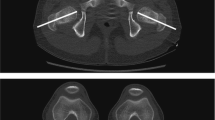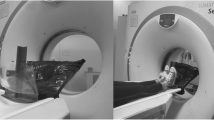Abstract
Femoral neck anteversion is the torsion of the femoral head with reference to the distal femur. Conventional methods that use cross-sectional computed tomography (CT), magnetic resonance or ultrasound images to estimate femoral anteversion have met with several problems owing to the complex, three-dimensional (3D) structure of the femur. These problems include not only the difficulty of defining the direction of the femoral neck axis and condylar line but also the dependency upon patient positioning. In particular, the femoral neck axis, the direction of the femoral head, known as the major source of error, is difficult to determine from either a single or several two-dimensional (2D) cross-sectional images. A new method has been devised for the measurement of femoral anteversion using the 3D imaging technique. 3D reconstructed CT images from the femoral head and trochanter to the distal femur are used to measure the anteversion. It is necessary to remove the soft tissue from the CT images and extract just the bone part. Then, the femoral anteversion is measured from a computer-rendered femur image. The 3D imaging method is compared with both the conventional 2D method and the physical method using 20 dried femurs. For the physical method, which is used as a reference value, a special apparatus is devised. The average difference between the results of the physical method and those of the 2D CT method is 5.33°. The average difference between the results of the physical method and those of the 3D imaging method is 0.45°. Seventy-four patients, who suffer from toe-in-gait disease, are tested to compare the 3D imaging method with the conventional 2D CT method. The average difference between the 2D and 3D methods is 8.6°, and the standard is 7.43°. This method provides a very accurate and reliable measurement of femoral anteversion, as it is virtually equivalent to the direct measurement of bisected dried femur in vitro.
Similar content being viewed by others
References
Abel, M. F., Sutherland, D. H., Wenger, D. R., andMubarak, S. J. (1994): ‘Evaluation of CT-scans and 3-D reformatted images for quantitative assessment of the hip’,J. Pediatr. Orthop.,14, pp. 48–53
Billing, L. (1954): ‘Roentgen examination of the proximal femur end in children and adolescents’,Acta Radiol. Diagn., (Suppl.),110
Egund, N., andPalmer, J. (1984): ‘Femoral anatomy described in cylindrical coordinates using computed tomography’,Acta Radiol. Diagn.,25, pp. 209–215
Hermann, K. L., andEgund, N. (1997): ‘CT measurement of anteversion in the femoral neck. The influence of femur positioning’,Acta Radiol.,38, pp. 527–532
Hernandez, R. J., Tachdjian, M. O., Poznanski, A. K., andDias, L. S. (1981). ‘CT determination of femoral torsion’,Am. J. Radiol.,137, pp. 97–101
Høiseth, A., Reikerás, O., andFonstelien, E. (1988): ‘Aspects of femoral neck anteversion. Theoretical considerations and experimental results’,Acta Radiol.,29, pp. 689–694
Høiseth, A., Reikerás, O., andFønstelien, E. (1989): ‘Evaluation of three methods for measurement of femoral neck anteversion. Femoral neck anteversion, definition, measuring methods and errors’,Acta Radiol.,30, pp. 69–73
Murphy, S. B., Simon, S. R., Kijewski, P. K., Wilkinson, R. H., andGriscom, N. T. (1987): ‘Femoral anteversion’,J. Bone Joint Surg.,69-A, pp. 1169–1176
Reikerás, O., Høiseth, A., andReigstad, A. (1985): ‘Femoral anteversion measured by the Dunlap/Rippstein and Norman methods’,Acta Radiol. Diagn.,26, pp. 303–305
Robb, R. A., andBarillot, C. (1986): ‘Interactive display and analysis of 3-D medical images’,IEEE Med. Imag.,8–3, pp. 217–226
Ruby, L., Mital, M. A., O'Connor, J., andPatel, U. (1979): ‘Anteversion of the femoral neck. Comparison of methods of measurement in patients’,J. Bone Joint Surg.,61-A, pp. 45–61
Schneider, B., Laubenberger, J., Jemlich, S., Groene, K., Weber, H. M., andLanger, M. (1997): ‘Measurement of femoral antetorsion and tibial torsion by magnetic resonance imaging’,Br. J. Radiol.,70, pp. 575–579
Weiner, D. S., andCook, A. J. (1980): ‘Practical considerations in the use of computed tomography in the measurement of femoral anteversion’,Isr. J. Med. Sci.,16, pp. 288–294
Wedge, J. H., Munkacsi, I., andLoback, D. (1989): ‘Anteversion of the femur and idiopathic osteoarthrosis of the hip’,J. Bone Joint Surg.,71-A, pp. 1040–1043
Yoshioka, Y., Siu, D., andCooke, T. D. V. (1987): ‘The anatomy and functional axes of the femur’,J. Bone Joint Surg.,69-A, pp. 873–880
Author information
Authors and Affiliations
Corresponding author
Rights and permissions
About this article
Cite this article
Kim, J.S., Park, T.S., Park, S.B. et al. Measurement of femoral neck anteversion in 3D. Part 1: 3D imaging method. Med. Biol. Eng. Comput. 38, 603–609 (2000). https://doi.org/10.1007/BF02344864
Received:
Revised:
Issue Date:
DOI: https://doi.org/10.1007/BF02344864




